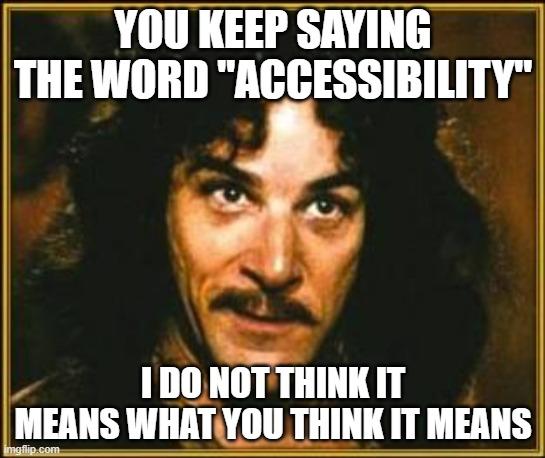
“Accessibility” is a word that you may hear in the context of college or a workplace. According to Dictionary.com, the word means “the quality of being suitable or adapted for use by people with disabilities.” If we think a little broader, we can use the working definition of “being easy to approach, reach, enter, speak with, use, or understand.” So, accessibility may be of particular concern/interest for those who serve people with disabilities, but the “gold standard” is to allow all things to be accessible to all people.
Students in my classrooms come with unique backgrounds, experiences, and ways of thinking. Teachers understand that no two brains work exactly the same way, so they will often have systems in place to ensure their practices are widely accessible. There are things we can do to “meet my students where they are.”
-Read every accommodation letter thoroughly to ensure that you understand the plan, and follow up with the student or advisor if you need more detail about how to serve the student.
-Use a planner to track students who need extra time, laptops, low-distraction, or other conditions. You can plan this ahead of time so students do not need to ask for their accommodations, as they have already been provided. Do not discuss accommodations in class at the risk of making any student feel “othered.”
-Can every student see? Consider printing large-text tests that students can choose, if they prefer. Allow them buy the book or rent the E-book, or purchase older editions if the text is expensive. In my estimation, they’re all pretty much the same anyway, we all know the textbook system is a racket.
-Can every student hear? Consider making sure that all your videos have close captions, and reach out to student accessibility services if they don’t. This office may also help you make sure that class transcripts are available and accurate.
-Do some students prefer to take notes on laptops? If so, consider letting students bring their laptops to class. For students who plan to watch funny cat videos during class, I ask them to sit in the back row.
-Consider giving extensions to students who ask for them. You don’t have to pry for details, only ask what a reasonable date would be for a submission. LIFE HAPPENS and college students are not immune from problems like a broken-down car, a conflicting work event, or a sudden illness. We can respect the privacy of students and understand that they’re juggling multiple social roles and responsibilities
-Consider making all lecture slides and recordings of videos available to all students. Some students will want to use them as a study tool, and others might ignore them completely, and that’s fine. There will inevitably be students who do not attend class and might rely on these resources to complete the class successfully, and while that’s a boring way to learn, in the end their learning is the most important goal.
-Consider making cameras optional in online classes. There was a HUGE scholarly debate about this practice from the onset of remote learning in Spring of 2020. Some teachers feel it’s really important to see your engagement and “save you from yourself” i.e. turning off your camera and playing on your phone. But it’s important to consider that some students have families at home (or large, squawking parrots in some cases) and some students don’t want you to see their bedrooms/living rooms/kitchens. Teaching remotely without student cameras feels like screaming into the abyss, but it’s better that teachers feel uncomfortable than students. There is also some evidence that watching oneself on the screen can exacerbate symptoms of social anxiety disorder. It’s very weird to see large, disembodied faces floating on a screen. Very unnatural.
-Consider presenting example test items before an exam so everyone knows what’s in store for them. A lot of test-taking stress involves unpredictability, so having examples to work from decreases stress for many students. I usually take a class as a “review” before an exam to wrap up any loose ends or answer any last questions. Making all students feel prepared is one way of making the class more accessible.
-The syllabus is a FANTASTIC opportunity to address accessibility. Do you remember the first time you looked at a syllabus? Did it feel like you were reading a foreign language? The idea of the syllabus goes way back to the start of the academy, and it reads like it- very old, very arcane. It’s a good idea for professors to review their syllabi often to reflect updated research on accessible practice. Some students may not have posted to online message boards before, so teachers should clearly outline their expectations. Some students may not have written a research paper before- so there should be a detailed rubric that explains what’s expected. Many teachers take a class to walk students through the syllabus to make sure everyone has a clear understanding of class protocol. As a quasi-legal document, it’s one of the most important protections for both students and teachers.
-Consider making online courses self-paced, particularly for adult learners. This definitely translates into more work for the educator, but it may make the course more accessible for adults who are trying to balance multiple roles and responsibilities.
-Consider allowing students revise and resubmit their work. By giving concrete, specific, and thorough feedback and allowing students to incorporate it is incredibly helpful to student learning.
Iff you’re wondering if accessible teaching makes a differences?
For students, I’d encourage you to use your accommodations, even if you don’t think you need them. If you suspect you may need accommodations, ask an advisor or mentor how to get the process started. Give people the opportunity to meet your needs. You might be surprised how people rise to the occasion.
